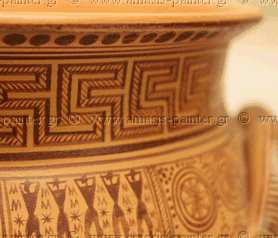Hellenic Pottery Painting
in Historical Times
|
A special interest is exhibited in the evolution of the decoration-composition. We can derive a lot of information from a primal source, starting from the simplest (everyday dressing, everyday life, myths) to the more complex (the kind of and the degree of self- realization at that time). The organization of the representations and the patterns is based on a deeper level of life and the “religious” perceptions.
The decorative system in its evolution shows a hierarchy that begins from the linear decoration of the geometric period (picture 1), (often with additional clay mouldings of mortuary symbolism — creatures/symbols of the nether world). It then passes to the world of animals and demonic creatures (picture 2), followed by the reproduction of the human figure (picture 3). It finally progresses to the utmost, in the world of heroes and gods (picture 4), but peaks in the narration of everyday moments of people (for instance, the narration of a real bridal parade (picture 5), and not the co-existence of human-formed and mythological beings in the composition of a mythical scene). (picture 6a,b).
At the beginning of this evolution, therefore, we have the simple linear patterns of the geometric style, followed by the strips with mythological animals and plant decorations of the early archaic period, and in a third phase, the narrative scenes. During the last part of this third phase, at the end of the 6th century BC, when themes began to consist only of human forms and narrative scenes, the powerful patterns are placed aside as margin ornaments. This is due to an increase of the painters’ self-confidence and the gradual decrease of the significance of mythical and supernatural forces. These changes occur as the order of the State is established and at the same time establishes rationalism, justice and philosophy on a course that ends with the “individual” – the personality with an objective internal world from which action will be emanated as materialization of the intention.
In early archaic times, the way of perceiving things is through myth. Man is in an inseparable unity with nature and human forms appear assimilated with mythical animals and huge plant ornaments (picture 7). Man is not the master of his actions, but “is possessed” by supernatural forces (sing Goddess…Iliad). Animism reaches a stage of incarnatio not only in objects (Amadriades, Melies) but also in intellectual categories (hours – time of cultivation, Fates – distribution – Isiodos). In the mid-archaic and post-archaic times with the retreat of the myth, the social and constitutional changes by Solon and Kleisthenis (when Dionysos from «μανιοδότης Ζαγρεύς» (gives mania) became tame, joins the State order), the anthropomorphism as human forming is expressed by Panes, Centaurs and the ever more charming Satyrs.
![]()
HAND MADE AND PAINTED IN GREECE






